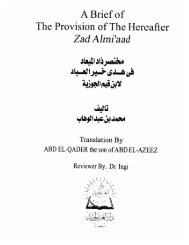You also want an ePaper? Increase the reach of your titles
YUMPU automatically turns print PDFs into web optimized ePapers that Google loves.
A <strong>Brief</strong> <strong>Guide</strong> to the <strong>Rites</strong> of <strong>Hajj</strong> and ‘<strong>Umrah</strong><br />
www.al-manhaj.com Al-Manhaj E-Books<br />
1
A <strong>Brief</strong> <strong>Guide</strong> to the <strong>Rites</strong> of <strong>Hajj</strong> and ‘<strong>Umrah</strong><br />
A <strong>Brief</strong> <strong>Guide</strong><br />
to the <strong>Rites</strong> of<br />
<strong>Hajj</strong> and <strong>Umrah</strong><br />
By Shaikh Abu Haatim Usaamah al-Qoosee<br />
Translated into English by:<br />
Muhammad Yaseen Vigna<br />
(Former student of Madeenah University)<br />
Cover Design by:<br />
Lougain <strong>To</strong>lak<br />
www.al-manhaj.com Al-Manhaj E-Books<br />
2
A web site of:<br />
<strong>The</strong> Salafi Society of North America<br />
New York, NY USA<br />
URL: www.al-manhaj.com<br />
E-mail: info@al-manhaj.com<br />
Tel/Fax: (917) 287-1331<br />
A <strong>Brief</strong> <strong>Guide</strong> to the <strong>Rites</strong> of <strong>Hajj</strong> and ‘<strong>Umrah</strong><br />
© Copyright www.al-manhaj.com<br />
AL-MANHAJ E-BOOKS<br />
Published on-line by www.al-manhaj.com<br />
Important Note:<br />
<strong>The</strong> following document is an on-line book publishing of www.al-manhaj.com. This book was<br />
formatted and designed specifically for being placed on the Web and for its easy and<br />
convenient distribution. At the time of this e-book publishing, we are not aware of any other<br />
book similar to it, in terms of its translation from its original Arabic source. Since this book<br />
was prepared for free on-line distribution we grant permission for it to be printed, disbursed,<br />
photocopied, reproduced and/or distributed by electronic means for the purpose of spreading its<br />
content and not for the purpose of gaining a profit, unless a specific request is sent to the<br />
publishers and permission is granted.<br />
www.al-manhaj.com Al-Manhaj E-Books<br />
3
A <strong>Brief</strong> <strong>Guide</strong> to the <strong>Rites</strong> of <strong>Hajj</strong> and ‘<strong>Umrah</strong><br />
INTRODUCTION TO THE BOOK<br />
All praise is due to Allaah and may His peace and blessings be on His final Messenger, his<br />
family and those who follow him in goodness until the Day of Judgement. <strong>To</strong> Proceed:<br />
This book is transcribed translation of a lecture Shaikh Usaamah Al-Qoosee gave while in<br />
New York, USA. <strong>The</strong> Shaikh gave this lecture in Masjid Ahlul-Qur’aan wa Sunnah in February<br />
of 2000 before <strong>Hajj</strong> time. <strong>The</strong> lecture was given in Arabic and then transcribed and<br />
translated by brother, Muhammd Yaseen afterward.<br />
<strong>The</strong> talk was very beneficial as the Shaikh mentioned the rites of <strong>Hajj</strong> and ‘<strong>Umrah</strong> in a simple<br />
and understandable form, making it apply to the audience he was directing his talk to –<br />
those in the west, particularly those in the United States.<br />
Shaikh Usaamah does not go into detail in this discussion and limits his words to just the<br />
main points, briefly mentioning the evidences from the Qur’aan and the Sunnah. By doing<br />
this, he gives a simple yet informational guide on how to perform the <strong>Hajj</strong> and ‘<strong>Umrah</strong>. This<br />
is beneficial for those who will be perfoming <strong>Hajj</strong> soon and do not have time to research the<br />
issue in depth or for those who just want a quick and brief guide on what to do during <strong>Hajj</strong><br />
or ‘<strong>Umrah</strong>.<br />
<strong>The</strong> reader will be able to easily follow the rites of <strong>Hajj</strong> and ‘<strong>Umrah</strong>, step and by step, as he<br />
goes along this treatise. <strong>And</strong> information is given as to what should be said during each<br />
point, as well as what should be done according to the Qur’aan and Sunnah.<br />
We ask Allaah to reward the Shaikh for his beneficial talk and that He place it on his Balance<br />
of good deeds on the Day of Judgement. <strong>And</strong> lastly, we ask that Allaah make this treatise a<br />
guide for those who wish to perform <strong>Hajj</strong>, and that it cause them to perform it correctly and<br />
properly, such that their <strong>Hajj</strong> will be accepted.<br />
Written by isma’eel alarcon<br />
For Al-Manhaj.Com<br />
On February 9, 2002<br />
www.al-manhaj.com Al-Manhaj E-Books<br />
4
A <strong>Brief</strong> <strong>Guide</strong> to the <strong>Rites</strong> of <strong>Hajj</strong> and ‘<strong>Umrah</strong><br />
TABLE OF CONTENTS<br />
1. <strong>The</strong> Obligation of <strong>Hajj</strong>..…………………………………………. 6<br />
2. <strong>The</strong> Mawaaqeet.…………………………………………………. 7<br />
3. Assuming the State of Ihraam…………………..……………….. 7<br />
4. <strong>The</strong> <strong>Rites</strong> of ‘<strong>Umrah</strong>…..……………………………………….. 8<br />
A. Ihraam.……………………………………………………… 9<br />
B. <strong>The</strong> Niyyah………………………………………..………… 9<br />
C. <strong>The</strong> Talbiyyah……………………………………………….. 11<br />
D. <strong>The</strong> Tawaaf…………………………………………….……. 12<br />
E. <strong>The</strong> Sa’ee……………………………………………………. 13<br />
F. Tahallul……………………………………………………... 15<br />
5. <strong>The</strong> <strong>Rites</strong> of <strong>Hajj</strong>………………………………………………… 16<br />
A. <strong>The</strong> Stay at Minaa…………………………………………… 17<br />
B. <strong>The</strong> Stay at ‘Arafah………………………………………….. 18<br />
C. <strong>The</strong> Stay at Muzdalifah……………………………………… 19<br />
6. <strong>The</strong> Prescribed <strong>Rites</strong> of the 10 th of Dhul-Hijjah..…………...…… 19<br />
A. <strong>The</strong> Ramee (Stoning)………………………………………... 20<br />
B. <strong>The</strong> Sacrifice…………………………………..…………….. 20<br />
C. Shaving the Head……………………………………..……... 21<br />
D. Tawaaf around the Ka’bah………………………………...… 21<br />
7. <strong>The</strong> Days of ‘Eid..…………...…………………………………... 22<br />
8. Special Cases: Women and Menstruation during <strong>Hajj</strong>…...……… 24<br />
9. <strong>The</strong> Preferability of <strong>Hajj</strong> At-Tamattu’………..…………...……... 25<br />
www.al-manhaj.com Al-Manhaj E-Books<br />
5
A <strong>Brief</strong> <strong>Guide</strong> to the <strong>Rites</strong> of <strong>Hajj</strong> and ‘<strong>Umrah</strong><br />
THE OBLIGATION OF HAJJ<br />
<strong>Hajj</strong> is obligatory on every Muslim only once during his or her lifetime, provided that he or she<br />
is able to perform it. <strong>The</strong> order comes from Allaah in the ayah:<br />
“<strong>Hajj</strong> (Pilgrimage) to the House (the Ka'bah) is an obligation that humanity owes<br />
to Allaah, for those who can find a way (i.e. for those who can find the means to do<br />
it). <strong>And</strong> whoever disbelieves (i.e. denies the <strong>Hajj</strong>), then Allaah is beyond any need<br />
of all that exists (from His creation).” [Surah Aali ‘Imraan: 197]<br />
<strong>And</strong> His order in the ayah:<br />
“<strong>The</strong> <strong>Hajj</strong> is in the well-known (lunar) months. So whoever intends to perform<br />
<strong>Hajj</strong> in these months, then he should not have sexual relations (with his wife), nor<br />
commit sin, nor argue unjustly during the <strong>Hajj</strong>.” [Surah Al-Baqarah: 197]<br />
<strong>And</strong> in His order:<br />
"Complete (perform properly) the <strong>Hajj</strong> and ‘<strong>Umrah</strong> for Allaah..." [Surah Al-Baqarah:<br />
196]<br />
From these previous ayaat we can conclude that <strong>Hajj</strong> is obligatory on every Muslim who has<br />
the (physical, financial, and circumstantial) ability to reach the sacred precincts of the Ka'bah<br />
at Makkah.<br />
As for those who have the ability to do so but do not perform <strong>Hajj</strong>, then they are committing a<br />
major sin from the major sins of Islaam and, moreoever it is one of the things that indicate<br />
Kufr (Disbelief).<br />
<strong>The</strong>refore, <strong>Hajj</strong> is obligatory once in a person's lifetime – for those who have the ability to do<br />
it. Whoever performs it more than once, then these extra <strong>Hajj</strong> are considered voluntary<br />
(naafilah).<br />
www.al-manhaj.com Al-Manhaj E-Books<br />
6
A <strong>Brief</strong> <strong>Guide</strong> to the <strong>Rites</strong> of <strong>Hajj</strong> and ‘<strong>Umrah</strong><br />
THE MAWAAQEET<br />
<strong>Hajj</strong> in regards to the Muslims living in this country (i.e. United States) commences when the<br />
Muslim travels to Makkah and makes the initial intention of ‘<strong>Umrah</strong>. He assumes his sacred<br />
state of Ihraam at the appointed places (Mawaaqeet), designated for asuming Ihraam when<br />
passing through those designated places.<br />
According to the statement of the Prophet (sallAllaahu ‘alayhi wa sallam): “<strong>The</strong> Mawaaqeet<br />
are the places designated for those wishing to assume Ihraam when they pass<br />
these places, not including the people (who already reside there).”<br />
<strong>The</strong>se are places specifically designated in order to assume Ihraam, known as Mawaaqeet<br />
(sing: Meeqaat). It is not permissible for anyone who wishes to perform <strong>Hajj</strong> or ‘<strong>Umrah</strong> to<br />
pass beyond these places towards Makkah without assuming the sacred state of Ihraam.<br />
<strong>The</strong>se specified places, known as the Mawaaqeet, extend from the direction of Makkah in four<br />
different directions. Whoever passes any one of these places going towards Makkah must<br />
assume Ihraam before proceeding, except for the residents of that place (and those living<br />
nearer to Makkah).<br />
As for you (here in the United States), the majority of you travel by plane through the<br />
direction of Egypt. <strong>The</strong>refore, you will take the same Meeqaat as the people of Egypt, which<br />
is also the same Meeqaat that is designated for the people of Shaam. This Meeqaat is known<br />
as "Raabig" and it is located about a ½ hour by air before reaching Jeddah. It is now a<br />
deserted, and abandoned town, known as al-Juhfah, or “<strong>The</strong> Dry Place", because of the<br />
frequent rain torrents (sayl) that wash over it on their way to the sea, leaving it barren.<br />
ASSUMING THE STATE OF IHRAAM<br />
It is not necessary to assume the state of Ihraam from America before leaving; since it is a<br />
long journey. So whoever travels from here in order to perform the <strong>Hajj</strong> should dress in his<br />
normal attire and carry his Ihraam clothing in his carry-on hand luggage, changing into it<br />
before the plane is approximately a ½ hour due to land at Jeddah.<br />
At this time, while assuming the Ihraam, your intention should be for ’<strong>Umrah</strong>. Why should<br />
your intention be for ‘<strong>Umrah</strong> and not for <strong>Hajj</strong>? Well, the answer lies in the hadeeth of the<br />
Messenger of Allaah (sallAllaahu ‘alayhi wa sallam) where he and his Companions gathered and<br />
collected animals designated for sacrifice along the way from Madeenah to Makkah, enclosing<br />
even more of them when approaching Makkah. All of them having the intention of only <strong>Hajj</strong>,<br />
they performed the Tawaaf (circumambulation) around the House (Ka'bah) and the Sa’ee<br />
between as-Safaa and al-Marwah, after which the Prophet (sallAllaahu ‘alayhi wa sallam) said<br />
clearly and decisively:<br />
www.al-manhaj.com Al-Manhaj E-Books<br />
7
A <strong>Brief</strong> <strong>Guide</strong> to the <strong>Rites</strong> of <strong>Hajj</strong> and ‘<strong>Umrah</strong><br />
“Whoever among you does not possess a hadee (a sacrificial animal), then let him<br />
make this (an ‘<strong>Umrah</strong>). He is to come out of the sacred state of Ihraam now and<br />
has fulfilled his duties and rites after completing it.”<br />
<strong>The</strong>n they were ordered to assume the Ihraam a second time, this time for <strong>Hajj</strong> on the 8 th of<br />
Dhul-Hijjah known as Yawm at-Tarwiyyah (<strong>The</strong> Day of Watering, i.e. for the people and the<br />
animals).<br />
So, we can divide those Hujaaj (pilgrims performing <strong>Hajj</strong>) into two groups:<br />
1. Those who possess and lead their sacrificial animals with them,<br />
2. Those who do not have their sacrificial animals with them.<br />
As for those who possess their sacrificial animals with them, then it is not possible for them to<br />
come out of their sacred state of Ihraam, due to the statement of Allaah:<br />
"<strong>And</strong> do not shave your heads until the hadee reaches the place of sacrifice." [Surah<br />
Al-Baqarah: 196]<br />
This means that it is impermissible to come out of Ihraam for whoever still has his hadee<br />
(sacrificial animal) in his possession until he reaches the place of slaughtering during <strong>Hajj</strong>.<br />
So whoever brings his sacrificial animal (hadee) with him before the Meeqaat, must remain in<br />
Ihraam for the duration of both the ‘<strong>Umrah</strong> and the <strong>Hajj</strong>, until its completion. This is the<br />
combination of <strong>Hajj</strong> and ‘<strong>Umrah</strong> together in one ordered arrangement of rites, known as <strong>Hajj</strong><br />
At-Qiraan.<br />
As for those who do not possess their sacrificial animals before the Meeqaat, including those<br />
who made their intention for <strong>Hajj</strong> only (at the Meeqaat), they must come out of their Ihraam<br />
after performing the Tawaaf and Sa'ee, thereby completing their ‘<strong>Umrah</strong>.<br />
So ‘<strong>Umrah</strong> is the beginning of the order of rites for <strong>Hajj</strong>. Since the majority of people do not<br />
bring their sacrificial animals with them nowadays, we will not concern ourselves with that<br />
type of <strong>Hajj</strong> (i.e. <strong>Hajj</strong> al-Qiraan)<br />
<strong>The</strong> Pillars (arkaan) of ‘<strong>Umrah</strong> are four:<br />
THE RITES OF ‘UMRAH<br />
1. Ihraam: which is assumed at the Meeqaat,<br />
www.al-manhaj.com Al-Manhaj E-Books<br />
8
A <strong>Brief</strong> <strong>Guide</strong> to the <strong>Rites</strong> of <strong>Hajj</strong> and ‘<strong>Umrah</strong><br />
2. Tawaaf: around the House, which consists of seven circuits,<br />
3. Sa'ee: between the hills of as-Safaa and al-Marwah, which consists of seven circuits,<br />
4. Tahallul: which means coming out of the sacred state of Ihraam, making lawful what<br />
which was previously prohibited during ihraam<br />
IHRAAM:<br />
Ihraam is assumed at the specified Meeqaat, or on the plane before passing the Meeqaat, as<br />
we have discussed before.<br />
<strong>The</strong> men are to change into their clothing of Ihraam while the women only need to make their<br />
intention at that time in the clothing they are already wearing. <strong>The</strong>re is no specific clothing<br />
designated for women, except that they are prohibited from wearing the Niqaab (face-veil) 1<br />
and gloves. Yes, it is obligatory and correct that women should cover their faces and hands<br />
(generally), but (at this time) it is forbidden for them to do so using the Niqaab and gloves.<br />
Instead, they should cover their hands with the lower part of their khimaar (head covering),<br />
while using the upper part of their jilbaab (outer garment) or a separate piece of fabric to<br />
cover their faces.<br />
This is the most preferred opinion according to the People of Knowledge, whereby the<br />
covering of the face and hands while in Ihraam is not forbidden, but rather what is prohibited<br />
is the wearing of these two specific articles of woman's clothing, designed to cover the face<br />
(niqaab) and the hands (gloves).<br />
<strong>The</strong>refore, women must cover their faces and hands with the clothing they are wearing, but<br />
are prohibited to use the Niqaab and gloves for that purpose.<br />
As for men, they must assume their Ihraam at the Meeqaat by wearing two pieces of fabric<br />
called the Izaar and the Ridaa'. <strong>The</strong> Ridaa' covers the top half of the body, while the Izaar<br />
covers the lower half. No other clothing is allowed to be worn in addition to these – no<br />
underwear, no pants, no shirt, no turban, no hat, etc. are to be worn.<br />
As for women, their Ihraam is limited to only their faces and hands. <strong>The</strong>y are not allowed to<br />
wear the face-veil or gloves, but must assume Ihraam in their regular clothing. Unlike men,<br />
they do not have special clothing to wear.<br />
THE NIYYAH:<br />
<strong>The</strong> intention (niyyah) is made at the Meeqaat to begin the state of Ihraam. <strong>The</strong> Prophet<br />
(sallAllaahu ‘alayhi wa sallam) said: “Actions are only by intention.”<br />
1 Translator’s Note: <strong>The</strong> Niqaab is a piece of clothing specifically designed for the purpose of<br />
covering the face and/or head and is in direct contact with the surface of the skin.<br />
www.al-manhaj.com Al-Manhaj E-Books<br />
9
A <strong>Brief</strong> <strong>Guide</strong> to the <strong>Rites</strong> of <strong>Hajj</strong> and ‘<strong>Umrah</strong><br />
<strong>The</strong> intention that enters one into the state of Ihraam must be made in the heart, while the<br />
statement made afterwards is:<br />
“Labayk Allaahumma Labayk.”<br />
This statement begins the rites of ‘<strong>Umrah</strong> and <strong>Hajj</strong> just as the pronouncement of Takbeer<br />
(saying Allaahu Akbar) begins the prayer. So just as a person enters into prayer with the<br />
opening Takbeer, likewise, the Muhrim enters into the sacred rites of <strong>Hajj</strong> and ‘<strong>Umrah</strong> by<br />
saying:<br />
“Labayk Allaahumma bi-‘<strong>Umrah</strong>” or<br />
“Labayk Allaahumma bi-<strong>Hajj</strong>.”<br />
When assuming Ihraam at the Meeqaat, it is sufficient to mention just the ‘<strong>Umrah</strong> in the<br />
opening Talbiyyah (i.e., say: Labayk Allaahumma bi-‘<strong>Umrah</strong>), since the person will be a<br />
Mutamatta'ee, i.e. he will be performing <strong>Hajj</strong> at-Tamattu’ (joining ‘<strong>Umrah</strong> with <strong>Hajj</strong>). Allaah<br />
says:<br />
"<strong>And</strong> whoever performs the ‘<strong>Umrah</strong> in the months of <strong>Hajj</strong> before (performing) the<br />
<strong>Hajj</strong> (i.e. <strong>Hajj</strong> at-Tamattu' and al-Qiraan), he must sacrifice a hadee such as he can<br />
afford without difficulty..." [Surah Al-Baqarah: 196]<br />
So whoever enters into Ihraam for ‘<strong>Umrah</strong>, he must complete his ‘<strong>Umrah</strong> and then come out<br />
of Ihraam. <strong>The</strong>n he must wait in Makkah until the 8 th of Dhul-Hijjah, then go into Ihraam<br />
another time, this time for <strong>Hajj</strong>, while in Makkah.<br />
This division between the <strong>Hajj</strong> and the ‘<strong>Umrah</strong> is known as at-Tamattu', and one who<br />
performs this type of <strong>Hajj</strong> is known as a Mutamatta'ee. A Mutamatta'ee is required to<br />
sacrifice an animal (hadee) in the sacred precincts during <strong>Hajj</strong> on the 10 th of Dhul Hijjah.<br />
So the first pillar of ‘<strong>Umrah</strong> is the Ihraam. <strong>The</strong> intention is made in the heart, while the<br />
tongue recites the opening Talbiyyah, which is: “Labbayk Allaahumma bi-‘<strong>Umrah</strong>”, or<br />
“Labbayka ‘<strong>Umrah</strong>.”<br />
www.al-manhaj.com Al-Manhaj E-Books<br />
10
A <strong>Brief</strong> <strong>Guide</strong> to the <strong>Rites</strong> of <strong>Hajj</strong> and ‘<strong>Umrah</strong><br />
This opens the sacred state of Ihraam exactly like the Takbeer opens the prayer. <strong>The</strong> Ihraam<br />
dress is then put on and the restrictions are:<br />
1. No sexual contact with your spouse<br />
2. No wearing of clothes that conform to the body surface (for men only)<br />
3. It is prohibited to wear pants, shirt, shoes, socks, khuffs (leather socks)<br />
Sandals can be worn as long as they do not extend above the anklebone.<br />
With regard to “No Sexual Contact”, this means no sexual intercourse, foreplay, kissing or<br />
anything that leads to the physical act of sexual intercourse. This is based on the statement<br />
of Allaah:<br />
“So, whoever intends to perform <strong>Hajj</strong>, then he should not have sexual intercourse<br />
(with his wife), nor commit sin, nor argue unjustly during the <strong>Hajj</strong>.” [Surah Al-<br />
Baqarah: 197]<br />
So no sexual relations between the husband and wife is allowed until they come out of<br />
Ihraam.<br />
THE TALBIYYAH:<br />
Now once the state of Ihraam has commenced, the calling of the Talbiyyah begins:<br />
“O Allaah, I am here at Your disposal, ready to serve only You. I am here for You,<br />
there is no partner (in worship) to You. I am ready to serve You. Surely, all Praise<br />
and Blessings, and the Ownership of all that You created is Yours (alone). <strong>The</strong>re is<br />
no partner (in worship) to You.”<br />
<strong>The</strong> Talbiyyah continues from the Meeqaat until one reaches Makkah. <strong>The</strong> recitation of the<br />
Talbiyyah should be done in a raised voice as well as individually and not in unison with a<br />
group.<br />
This repetition out loud continues until the Muhrim enters Makkah and sets sight on the<br />
Sacred Masjid and the Ka'bah. It is at this point that we come to the second pillar of ‘<strong>Umrah</strong>,<br />
which is:<br />
www.al-manhaj.com Al-Manhaj E-Books<br />
11
THE TAWAAF:<br />
A <strong>Brief</strong> <strong>Guide</strong> to the <strong>Rites</strong> of <strong>Hajj</strong> and ‘<strong>Umrah</strong><br />
<strong>The</strong> Tawaaf of the Sacred House consists of making seven circuits around it. <strong>The</strong> Tawaaf<br />
always begins at the Hajr al-Aswad (<strong>The</strong> Black Stone), or at the point where you can greet it.<br />
Each circuit of the Tawaaf begins at the Black Stone. By pronouncing the Takbeer (saying<br />
Allaahu Akbar), he begins the first circuit. Each time the Muhrim circumambulates the Ka'bah<br />
and returns to the point of the Black Stone, he must repeat the Takbeer while pointing at the<br />
Black Stone.<br />
If the Muhrim (a person in the state of Ihraam) is able to do so, he may kiss the Black Stone<br />
with his lips or alternatively, he can wipe over the Black Stone with his hands or any other<br />
object and then kiss that object. Or if the crowds are too heavy, merely pointing in its<br />
direction with your hand is sufficient. Do not oppress or cause harm to those around you in<br />
your attempt to kiss or touch the Black Stone.<br />
<strong>The</strong> Tawaaf consists of seven circuits. <strong>The</strong>re is no specific statement or supplication legislated<br />
to be said during each circuit. <strong>The</strong>re are some books available with specific du'aas<br />
(supplications) for each circuit; i.e. the first, second, third, etc. <strong>The</strong>se books contain<br />
innovations and are a misguidance, so they should be avoided.<br />
Make du'aa from your heart, for that which will benefit you. Recite whatever you wish,<br />
supplicate to Allaah by asking for good, make dhikr (remembrance) of Allaah, recite the<br />
Qur'aan, anything you wish. <strong>The</strong>re are no specific statements or supplications to be recited<br />
during the Tawaaf that are authentically established in the Sunnah.<br />
<strong>The</strong> completion of seven circuits means you have completed the Tawaaf al-Qudoom (<strong>The</strong><br />
Tawaaf of Arrival). This particular Tawaaf al-Qudoom is to be performed in a specific way:<br />
<strong>The</strong> first three circuits are performed as "Ramal", i.e. taking short quick steps, not running<br />
with long strides. This is walking, with fast short strides for the first three circuits only. <strong>The</strong><br />
remaining four circuits are completed by walking at your normal pace.<br />
When beginning the Tawaaf al-Qudoom, the Muhrim should adjust his Ridaa (top piece of<br />
fabric) by lowering the right side under his right armpit and throwing the end over his left<br />
shoulder, thus exposing his right shoulder.<br />
This manner of wearing the Ridaa is only done for the seven circuits of the Tawaaf. From the<br />
time the Muhrim puts on his Ihraam garments at the Meeqaat until he reaches Makkah and is<br />
about to begin his Tawaaf al-Qudoom, he should wear his Ridaa such that it covers both<br />
shoulders.<br />
<strong>The</strong> Ramal is a manner of brisk pace in walking; taking short strides, and it is done only for<br />
the first three circuits. <strong>The</strong> remaining four are accomplished in your normal walking pace.<br />
www.al-manhaj.com Al-Manhaj E-Books<br />
12
A <strong>Brief</strong> <strong>Guide</strong> to the <strong>Rites</strong> of <strong>Hajj</strong> and ‘<strong>Umrah</strong><br />
<strong>The</strong> Muhrim must do the Ramal of the first three circuits from the Black Stone to the<br />
Rukn al-Yamanee (<strong>The</strong> Southwestern Corner) only. <strong>The</strong> distance between the Rukn al-<br />
Yamanee and the return to the Black Stone should be covered in your normal walking pace.<br />
This is done for three circuits. <strong>The</strong> remaining four are accomplished in your normal walking<br />
pace throughout.<br />
This is the complete description of the Tawaaf al-Qudoom.<br />
Remember, while performing it, the Muhrim should make du'aa and supplicate to his Lord by<br />
any means he wishes. This can be accomplished in Arabic or in any language other than<br />
Arabic such as English. What is important is that the slave of Allaah asks Him from his heart,<br />
while knowing the meaning of what he is supplicating for. It is not good that one makes<br />
du'aa and requests something when he does not even understand what he is asking for. One<br />
can make du'aa in his native language, so long as it comes from his heart (with good, pure<br />
intention, as Allaah Hears All).<br />
When the Tawaaf al-Qudoom is completed, with all of its components, the Muhrim then goes<br />
to the area known as the "Maqaamu-Ibraaheem" (<strong>The</strong> Place of Ibraaheem's Standing), where<br />
he performs a two-rak’aat prayer of Tawaaf.<br />
From here, the Muhrim descends to the well of Zam-Zam, where he drinks the water of Zam-<br />
Zam until he fills his stomach completely and also pours it over his body. Verily, Zam-Zam<br />
water is not only a nutrient, but it is also a cure from disease. After he drinks as much Zam-<br />
Zam as his stomach can hold, he returns to the Black Stone and recites the Takbeer (Allaahu<br />
Akbar) and thus completes the second pillar of ‘<strong>Umrah</strong>, the Tawaaf.<br />
AS-SA’EE:<br />
At this point the Muhrim now moves to the small hill, named as-Safaa and recites the ayah of<br />
Allaah:<br />
“Verily, as-Safaa and al-Marwah are from the signs of Allaah.” [Surah Al-Baqarah:<br />
158]<br />
<strong>The</strong>n he must say:<br />
“We begin with that which Allaah has begun with.”<br />
www.al-manhaj.com Al-Manhaj E-Books<br />
13
A <strong>Brief</strong> <strong>Guide</strong> to the <strong>Rites</strong> of <strong>Hajj</strong> and ‘<strong>Umrah</strong><br />
<strong>The</strong> Muhrim then climbs part of the way up the hill of as-Safaa and faces the Ka'bah until he<br />
can see it, if possible, and then recites:<br />
“Allaah is the Greatest. Allaah is the Greatest. <strong>The</strong>re is no one worthy of worship<br />
except Allaah – alone and without partner. <strong>To</strong> Him belongs all the Dominion and<br />
the Praise, He gives life and causes death. <strong>And</strong> He is Able to do anything. <strong>The</strong>re is<br />
no one worthy of worship except for Allaah – alone and with no partner. He has<br />
fulfilled His Promise and He has aided His slave (Muhammad). <strong>And</strong> He alone has<br />
defeated and destroyed the Confederates (of Disbelief).”<br />
After reciting this, you should then make du'aa for whatever Allaah opens your heart to. This<br />
can be done in any language, even in English. After completing your supplication, repeat the<br />
same opening supplication as before (the one above). <strong>The</strong>n, make du'aa a second time (for<br />
that which benefits you). After that, repeat the opening supplication a third time, followed by<br />
more du'aa on your behalf.<br />
After completing this supplication, descend from the hill of as-Safaa and head towards the hill<br />
of al-Marwah until you reach the first and second green pillars (indicating the ancient bottom<br />
of the valley between the two hills) and run quickly between these two green pillars. This<br />
running in the bottom of the valley reminds us of the actions of Umm Isma’eel, Hajar, who<br />
when descending into the valley between the two hills of as-Safaa and al-Marwah, ran quickly<br />
in order to climb to the higher point on the other hill and thus be able to see if her infant son,<br />
Isma'eel, was in distress or not. She walked the remaining distance on either side of the<br />
valley, as we do today. So, we remind ourselves of the patience, sacrifice, and duty the<br />
mother of Isma'eel, Hajar, undertook for the sake of Allaah.<br />
So we continue all seven routes between Safaa and Marwah the same way: walking until the<br />
green pillars, then running in between them, then walking the remainder of the distance to<br />
the next hill.<br />
What do we say or recite during this Sa’ee? Well, you should recite whatever you wish, as<br />
was the case in the Tawaaf, even in the English language. <strong>The</strong>re are no prescribed<br />
supplications to be made during the Sa’ee. Keep away from those books that contain false<br />
www.al-manhaj.com Al-Manhaj E-Books<br />
14
A <strong>Brief</strong> <strong>Guide</strong> to the <strong>Rites</strong> of <strong>Hajj</strong> and ‘<strong>Umrah</strong><br />
du'aas in them of which there is no basis for them in the Sunnah. Make du'aa from your<br />
heart.<br />
When reaching the hill of al-Marwah, you must climb it part of the way up, face the Ka'bah<br />
and recite the very same supplication and then your own du'aa – three times – exactly as you<br />
performed on the hill of as-Safaa.<br />
Do not do what the other people do when they reach the hill, such as shouting Takbeer<br />
(Allaahu Akbar) then moving on to the next hill. This is wrong. Stop, repeat the supplication<br />
we have learned (above), make your du'aa then go on to the next point.<br />
Leaving from al-Marwah, walk back towards as-Safaa, until you reach the "Green Mile" and<br />
then run as before. On the hill of as-Safaa, repeat exactly the same statements and du'aa as<br />
you did before then proceed back to al-Marwah.<br />
Going from as-Safaa to al-Marwah is a complete circuit (i.e. the first circuit) and from al-<br />
Marwah back to as-Safaa is another circuit (i.e. the second circuit), and so on. This goes on<br />
until you complete seven circuits and end up on al-Marwah.<br />
Some of the ignorant people assume that one complete circuit is going from as-Safaa to al-<br />
Marwah then from al-Marwah back to as-Safaa. This is wrong. Going from as-Safaa to al-<br />
Marwah is one complete circuit, and going from al-Marwah back to as-Safaa is another<br />
complete circuit.<br />
<strong>The</strong>refore, you commence the Sa'ee on as-Safaa and complete it on al-Marwah; after seven<br />
circuits. This completes the third pillar of ‘<strong>Umrah</strong>.<br />
TAHALLUL:<br />
Now we come to the fourth and final pillar of ‘<strong>Umrah</strong>, which is the shaving or the cutting the<br />
hair. This takes one out of Ihraam (known as Tahallul).<br />
Shaving the entire head is better than cutting the hair, at all times, except during the ‘<strong>Umrah</strong><br />
that is connected to the <strong>Hajj</strong> (at-Tamattu’). In this case, it is preferable to cut the hair after<br />
the ‘<strong>Umrah</strong>, leaving some hair on the head in order to be able to shave the head completely<br />
after the completion of Ihraam for the <strong>Hajj</strong>. Cutting the hair completes the order of rites of<br />
the ‘<strong>Umrah</strong>, and this brings you out of the state of Ihraam (Tahallul), thus making Halaal<br />
(permissible) to you that which was prohibited during the sacred state of Ihraam.<br />
You may have sexual relations with your wives, wear scented oils or perfume, wear a<br />
"Qamees" or a turban, etc. You are now free of Ihraam and have become “one who is able<br />
to enjoy and partake with pleasure in those things now permissible without<br />
Ihraam” in between the ‘<strong>Umrah</strong> and the <strong>Hajj</strong>. As Allaah has mentioned:<br />
www.al-manhaj.com Al-Manhaj E-Books<br />
15
A <strong>Brief</strong> <strong>Guide</strong> to the <strong>Rites</strong> of <strong>Hajj</strong> and ‘<strong>Umrah</strong><br />
“Whosoever performs ‘<strong>Umrah</strong> before the <strong>Hajj</strong> (at-Tamattu') must sacrifice a hadee<br />
such as he can afford without difficulty.” [Surah Al-Baqarah: 196]<br />
During this period, remain in Makkah and visit the scholars; recite the Qur'aan; perform your<br />
prayers in the Haram (Sacred Mosque) – do whatever you wish, but don't waste your time by<br />
talking idly with your friends or by arguing. Obtain the most benefit of your time there by<br />
visiting the scholars and going to their classes, engaging in the remembrance of Allaah, etc.,<br />
until the 8 th of Dhul-Hijjah arrives.<br />
On the 8 th of Dhul-Hijjah, known as Yawm at-Tarwiyyah, you must enter into the sacred state<br />
of Ihraam a second time, which is now the Ihraam of <strong>Hajj</strong>. This is accomplished wherever<br />
you are, whether inside the (Masjid) Al-Haram, or at the hotel in which your are staying.<br />
I forgot to mention earlier when discussing the Ihraam, that is is preferable (mustahabb) to<br />
take a bath and apply scented oil or perfume before donning the clothes of Ihraam. But it is<br />
not obligatory, so if you do not take a bath prior to Ihraam, there is no harm.<br />
If you applied scent before Ihraam and the scent remained in your head or beard after<br />
entering into Ihraam, there is no harm. What is prohibited is to apply a scent after the<br />
Ihraam has been assumed. This is Haraam (prohibited). Any effects from previously applying<br />
scent upon the head, body, or beard, before assuming Ihraam, is overlooked.<br />
THE RITES OF HAJJ<br />
<strong>The</strong> 8 th of Dhul Hijjah commences the order of the rites of <strong>Hajj</strong>:<br />
Do you have to return to the Meeqaat in order to assume the Ihraam? No, the Ihraam is<br />
assumed from any place you are staying at in Makkah, whether in a hotel or the Haram<br />
(Sacred Mosque) – anywhere you are staying at. You do not have to return to the Meeqaat<br />
you originally passed for your Ihraam of ‘<strong>Umrah</strong>.<br />
<strong>The</strong> rites of Ihraam are the same as before, the first (pillar) being the niyyah (the intention),<br />
where the intention is made in the heart, not in words or statements such as: “I wish to<br />
perform <strong>Hajj</strong>.” No, this intention should be limited to the heart only.<br />
After making the intention, the first opening statement is: “Labbayk Allaahumma bi-<br />
<strong>Hajj</strong>in” or, “Labbayk <strong>Hajj</strong>atan.”<br />
www.al-manhaj.com Al-Manhaj E-Books<br />
16
A <strong>Brief</strong> <strong>Guide</strong> to the <strong>Rites</strong> of <strong>Hajj</strong> and ‘<strong>Umrah</strong><br />
Here we come to an important point (about the intention). Some people while in Ihraam fall<br />
ill during <strong>Hajj</strong> and are unable to complete the rites of <strong>Hajj</strong>. If this occurs, the person must<br />
repeat his <strong>Hajj</strong> next year 2 and offer a sacrifice (in Makkah) as a penalty (fidyah) before being<br />
able to come out of the sacred state of Ihraam. <strong>The</strong>refore, it is from the Sunnah to make a<br />
condition for extenuating (unforeseen) circumstances at the time you are making your<br />
intention by saying after you recite:<br />
“Labbayk Allaahumma bi-<strong>Hajj</strong>in”, then<br />
“O Allaah, the place where I leave my sacred state (of Ihraam) is wherever You<br />
have prevented me (from continuing).”<br />
So whoever says this statement after reciting “Labbayk Allaahumma bi-<strong>Hajj</strong>” or “Labbayk<br />
Alaahumma bi-‘<strong>Umrah</strong>” and then becomes ill and unable to complete the order of rites of<br />
‘<strong>Umrah</strong> or <strong>Hajj</strong>, he can leave his Ihraam at any point he is at during the sacred order of rites<br />
without having to sacrifice a hadee or completing the remaining rites. Nothing else remains<br />
obligatory on him in that case.<br />
This statement means: "Allaah has ordained that I will be unable to complete and<br />
continue with the remainder of my rites. <strong>The</strong>refore, I will now come out of Ihraam<br />
and nothing else is necessary upon me."<br />
If someone is unable to continue his <strong>Hajj</strong> or ‘<strong>Umrah</strong> for any reason whatsoever, but he did not<br />
make this verbal condition at the time of saying “Labbayk Allaahumma bi-<strong>Hajj</strong>/bi-<br />
’<strong>Umrah</strong>”, then it is obligatory on him to sacrifice a hadee before coming out of Ihraam at that<br />
point, without completing the remainder of the rites.<br />
So you commence the sacred state (of Ihraam) by reciting: "Labbayk Allaahumma bi-<br />
<strong>Hajj</strong>" or "Labbayk Allaahumma <strong>Hajj</strong>a" or even "Labbayk <strong>Hajj</strong>atan"<br />
THE STAY AT MINAA:<br />
<strong>The</strong> stay at Minaa occurs on the 8 th day of Dhul-Hijjah. <strong>The</strong> Muhrim sets out and heads<br />
towards Minaa, where he should arrive and remain at so that the Dhuhr, 'Asr, Maghrib, Ishaa'<br />
and Fajr prayers are all performed there.<br />
2 Translator’s Note: This is if this was his first time making <strong>Hajj</strong>. He must repeat it since it is still<br />
obligatory on him to perform it at least once in his lifetime. But if this was his second time, then he<br />
need not repeat it unless he does so voluntarily.<br />
www.al-manhaj.com Al-Manhaj E-Books<br />
17
A <strong>Brief</strong> <strong>Guide</strong> to the <strong>Rites</strong> of <strong>Hajj</strong> and ‘<strong>Umrah</strong><br />
So, the Muhrim remains at Minaa so that he can perform the Dhuhr prayer on the 8 th of Dhul-<br />
Hijjah until the Fajr prayer on the 9 th of Dhul-Hijjah. In the A.M., a little before Dhuhr time on<br />
the 9 th of Dhul-Hijjah, the Muhrim sets out for (the plain of) 'Arafah.<br />
<strong>The</strong> Muhrim should not enter ‘Arafah until he arrives around Dhuhr time. When arriving at<br />
this time, he performs the Dhuhr and ‘Asr prayers, each being shortened to two rak'aat. It is<br />
preferable to pray these prayers with the Jam'aah (congregation). But if this is not possible,<br />
then you may perform the combined and shortened prayers on your own. First, make the<br />
Iqaamah and perform the Dhuhr prayer in two rak'aat. <strong>The</strong>n make the Iqaamah again and<br />
perform the ‘Asr prayer in two rak'aat.<br />
After completing these prayers you may enter (the plain of) ‘Arafah.<br />
THE STAY AT ‘ARAFAH:<br />
You then are to remain at ‘Arafah repeating the Talbiyyah. We forgot to mention before, you<br />
should also recite the Talbiyyah from the beginning of the Ihraam for <strong>Hajj</strong> just as it was<br />
recited from the beginning of the Ihraam for ‘<strong>Umrah</strong>.<br />
Also while at ‘Arafah, you can recite the Qur'aan and make supplication for whatever you<br />
wish, from your heart, as much as Allaah allows you, even in your own language. <strong>The</strong><br />
Qur'aan, when being recited, however, must be done in Arabic. Anything other than that can<br />
be done in English, i.e. remembrance of Allaah; supplications, etc. All of these can be done in<br />
English.<br />
<strong>The</strong>re are no prescribed prayers or supplications for 'Arafah, so there is no need for (prayer)<br />
books. Just make your du'aa and your remembrance of Allaah in any way you know, as long<br />
as it comes (sincerely) from the heart. Make Takbeer (saying Allaahu Akbar), Tasbeeh (saying<br />
SubhaanAllaah) or Tamheed (saying Alhamdulillaah).<br />
You remain at 'Arafah from Dhuhr until the time of sunset (Maghrib), which ends the stay at<br />
‘Arafah. <strong>The</strong> stay at ‘Arafah is the most important pillar (rukn) of the <strong>Hajj</strong>. Whoever does not<br />
witness (the day) at ‘Arafah, his <strong>Hajj</strong> is unacceptable. This is based on the hadeeth of Allaah’s<br />
Messenger: “<strong>The</strong> <strong>Hajj</strong> is 'Arafah.”<br />
So what does one do at 'Arafah? Should he climb the mountain at 'Arafah? No, it is not<br />
necessary to do this, for verily, the Prophet (sallAllaahu ‘alayhi wa sallam) never climbed the<br />
mountain at 'Arafah. Rather, he remained (upon his camel) at the foot of the mountain.<br />
One should engage himself in the remembrance of Allaah, supplication from the heart, reciting<br />
the Talbiyyah. You should not get involved with the people in idle talk or disputes, but rather,<br />
remain alone in order to call to Allaah, praise Him, magnify Him and glorify Him.<br />
www.al-manhaj.com Al-Manhaj E-Books<br />
18
THE STAY AT AL-MUZDALIFAH:<br />
A <strong>Brief</strong> <strong>Guide</strong> to the <strong>Rites</strong> of <strong>Hajj</strong> and ‘<strong>Umrah</strong><br />
Once the sun sets, you leave 'Arafah and set out for al-Muzadalifah. Usually, if you walk the<br />
distance, you will arrive sooner than if you were to take a vehicle there (because of the<br />
crowds). However, there is no harm in riding over there, because the Prophet (sallAllaahu<br />
‘alayhi wa sallam) rode (on a camel) from ‘Arafah to al-Muzdalifah. If you are unable to walk,<br />
then ride there. <strong>And</strong> if you are able to get there faster than by vehicle, then walk to al-<br />
Muzdalifah.<br />
Once in al-Muzdalifah, you are now within the sacred precincts of Makkah, where you must<br />
spend the remainder of the night (until Fajr). Many of the "Muttawafeen" (those responsible<br />
for leading people through the different rites of <strong>Hajj</strong>) bring the pilgrims directly to Minaa,<br />
without stopping at al-Muzdalifah. This is wrong.<br />
Spending the entire night at al-Muzdalifah is obligatory (waajib). <strong>The</strong> <strong>Hajj</strong> makes the stay at<br />
al-Muzdalifah mandatory until the sunrise of the following morning.<br />
When you first arrive at al-Muzdalifah, you are to perform the Maghrib prayer in three rak'aat<br />
and the 'Ishaa prayer in two rak'aat, combining the two prayers. You make one Adhaan and<br />
Iqaamah before each of the two prayers. Upon completing the two prayers, you can go to<br />
sleep. <strong>The</strong>re are no other required prayers for the remainder of the night at al-Muzdalifah.<br />
So you may sleep until the appearance of Fajr, whereupon you awaken and perform the two<br />
rak'aat Sunnah of Fajr, followed by the two rak'aat for Fajr prayer. <strong>The</strong>n you should remain<br />
there and remember Allaah, as Allaah says:<br />
“<strong>The</strong>n when you leave ‘Arafaat, remember Allaah at the Mash'ar-il-Haraam (i.e. al-<br />
Muzdalifah).” [Surah Al-Baqarah: 198]<br />
“Mash'ar-il-Haraam” here means al-Muzdalifah and “Remembering Allaah” can be done<br />
by making Tahleel (saying Laa Ilaaha IllAllaah), Tasbeeh (saying SubhaanAllaah), Takbeer or<br />
the Talbiyyah. <strong>The</strong>re are no prescribed supplications or statements during this time. Make<br />
the best of your own du'aa, in the language you can understand. You remain at al-Muzdalifah<br />
until just a little before the sun rises. <strong>The</strong>n you get up and leave, walking towards Minaa, not<br />
arriving there until after the sun rises.<br />
THE PRESCRIBED RITES OF THE 10 TH OF DHUL-HIJJAH<br />
This is now the 10 th of Dhul Hijjah, the greatest day of <strong>Hajj</strong>. On this day there are four<br />
prescribed rites:<br />
www.al-manhaj.com Al-Manhaj E-Books<br />
19
A <strong>Brief</strong> <strong>Guide</strong> to the <strong>Rites</strong> of <strong>Hajj</strong> and ‘<strong>Umrah</strong><br />
1. Throwing (pebbles) at the Jamrat-ul-‘Aqabah<br />
2. <strong>The</strong> Sacrifice (of a hadee)<br />
3. Shaving the head<br />
4. Tawaaf of the Ka'bah (seven times)<br />
THE RAMEE:<br />
Throw seven pebbles at the Pillar of ‘Aqabah, reciting “Allaahu Akbar” each time you throw.<br />
You may obtain these pebbles from wherever you find them on the road. Gather seven<br />
pebbles, each being the size of a little larger than a chickpea, and a bit smaller than a lima<br />
bean. This size of a pebble is known as khadhif, which is a small pebble that can be grasped<br />
and thrown by the forefinger and thumb.<br />
<strong>The</strong>se pebbles are to be gathered in your hand and thrown individually, one by one at the<br />
Jamrat-ul-‘Aqabah repeating "Allaahu Akbar" with each throw, i.e. saying “Allaahu Akbar” with<br />
the first pebble, “Allaahu Akbar” with the second throw and so on.<br />
Do not throw all seven pebbles together at once, and do not throw them from a far-away<br />
distance. You must stand as close as possible to the Jamrat (pillar) before throwing, to avoid<br />
causing harm to the people near the Jamrat ahead of you.<br />
<strong>The</strong> pillar of stone (jamrat) at which you are throwing the pebbles at is not the Devil! Some<br />
people think that it’s the Devil, so they yell and curse at the pillar, and throw their sandals at<br />
it. Some even climb up the pillar striking it and cursing it all the while! This is wrong and not<br />
correct. <strong>The</strong> pillar is not the Devil. It is only the “Jamrat-ul-‘Aqabah.” It is one of the<br />
prescribed rites of the <strong>Hajj</strong>. You must perform all the obligatory rites, even if you don’t know<br />
why you are doing them.<br />
THE SACRIFICE:<br />
After completing the seven throws, saying the Takbeer with each one, you return to the place<br />
of slaughtering at Minaa.<br />
<strong>The</strong>re you sacrifice your hadee (sacrificial animal). It is preferred to sacrifice the animal with<br />
your own hand at the slaughterhouse, or alternatively, you can designate by proxy someone<br />
else to slaughter on your behalf (i.e. by purchasing a voucher) at the Rajhu Bank (located<br />
there).<br />
<strong>The</strong>re are no special conditions related to the size or age of the hadee (animal to be<br />
sacrificed), as is in the case with the udhiyyah (animals sacrificed on ‘Eid by the non-pilgrims<br />
away from Makkah). Many scholars have made Qiyaas (comparative judgement) that the<br />
hadee is comparable to the standards of the udhiyyah and it is not permissible to be under a<br />
www.al-manhaj.com Al-Manhaj E-Books<br />
20
A <strong>Brief</strong> <strong>Guide</strong> to the <strong>Rites</strong> of <strong>Hajj</strong> and ‘<strong>Umrah</strong><br />
certain age or size, etc. What is correct is that you may slaughter an animal of any age, for<br />
verily Allaah has said:<br />
"...must sacrifice a hadee such as he can afford without difficulty." [2: 196]<br />
So Allaah did not make the condition that the hadee must be of a particular age, such as "this<br />
goat or sheep of 6 months or 1 year of age".<br />
Make the sacrifice of an animal you can easily afford, even if it is a small one – whatever size<br />
that you can afford without difficulty. A person with little funds can sacrifice only a small<br />
hadee while a rich person may sacrifice a big hadee.<br />
It is the Sunnah to perform the slaughter with your own hands, and to remove the liver, roast<br />
it, and then eat from it. If you cannot do this, there is no problem. Even if you delegate<br />
someone else to do it by proxy, as that may be easier for you, then you have indeed<br />
completed this important obligation of <strong>Hajj</strong>.<br />
SHAVING THE HEAD:<br />
After the sacrifice, you return and have your head shaved.<br />
TAWAAF OF THE KA’BAH:<br />
<strong>The</strong>n return to Makkah and perform the Tawaaf at the Haram, seven circuits, just as you did<br />
when you first arrived, except in this Tawaaf, which is known as the Tawaaf al-Ifaadah,<br />
there is no "walking the first three circuits in quick short steps", nor “wearing your top<br />
garment (Ridaa) with your right shoulder exposed.”<br />
You perform the entire Tawaaf walking, and it can be done while wearing your regular<br />
clothes.<br />
So when do you officially come out of Ihraam? It occurs as soon as you complete the stoning<br />
of the Jamrat-ul-‘Aqabah. Afterwards, you may immediately remove the garments of Ihraam<br />
and put on your normal clothing. This stage is known as <strong>The</strong> Lesser Ihraam, whereby<br />
everything that was allowable before Ihraam is once again lawful except sexual contact with<br />
spouses.<br />
Once you have completed this Tawaaf, your Ihraam is completely lifted, and everything<br />
previously lawful is again allowable, including sexual contact with your spouses.<br />
www.al-manhaj.com Al-Manhaj E-Books<br />
21
A <strong>Brief</strong> <strong>Guide</strong> to the <strong>Rites</strong> of <strong>Hajj</strong> and ‘<strong>Umrah</strong><br />
So on the 10 th of Dhul Hijjah, the following rites are to be performed:<br />
1. <strong>The</strong> Stoning of Jamrat-ul-‘Aqabah<br />
2. <strong>The</strong> Sacrifice of a hadee<br />
3. Shaving the head<br />
4. Tawaaf of the House (Ka’bah), seven circuits<br />
<strong>The</strong>se are the rites of Yawm an-Nahr (<strong>The</strong> Day of Sacrifice).<br />
Is it permissible to change the sequence of these rites and perform one of them before or<br />
after another? Yes! Verily the Prophet (sallAllaahu ‘alayhi wa sallam) was asked concerning<br />
the one who performed such and such a rite before another, or such and such a rite after<br />
another, he (sallAllaahu ‘alayhi wa sallam) replied: “(Go ahead and) do it, there is no<br />
harm. Do it there is no harm.”<br />
It is permissible to supercede one of the rites of Yawm an-Nahr over another, in order to<br />
make it easier or more appropriate to your own particular situation. So you may find yourself<br />
with people (in your <strong>Hajj</strong> group) who only may perform the Tawaaf by mid-morning or by the<br />
time of Dhuhr. What is important is that you perform the four obligatory rites:<br />
1. <strong>The</strong> Stoning of the Jamrat ul-‘Aqabah<br />
2. Sacrifice a hadee<br />
3. Shave the head<br />
4. Tawaaf of the House, seven circuits, known as Tawaaf al-Ifaadah (<strong>The</strong> Tawaaf of<br />
Return).<br />
So the Tawaaf is one of the obligations of this day, after which when completed, you are now<br />
completely free of your Ihraam restrictions, including sexual contact with your wives. After<br />
this stage, you are allowed to have marital relations with your lawful spouses, if they are<br />
accompanying you on this <strong>Hajj</strong>.<br />
THE DAYS OF ‘EID<br />
<strong>The</strong> only thing that remains for you in the <strong>Hajj</strong> is to stay at Minaa three days, or three nights.<br />
What are the activities to be performed while staying at Minaa?<br />
<strong>The</strong> days at Minaa are for eating, drinking, and for making remembrance of Allaah.<br />
Remember Allaah the best way that you are able to – there are no prescribed statements to<br />
be recited.<br />
Eat from your sacrificial animal, if you slaughtered it yourself. If you did it by way of proxy or<br />
voucher, then of course, that meat you will not see, and it will be donated in the way of Allaah<br />
(to the needy).<br />
www.al-manhaj.com Al-Manhaj E-Books<br />
22
A <strong>Brief</strong> <strong>Guide</strong> to the <strong>Rites</strong> of <strong>Hajj</strong> and ‘<strong>Umrah</strong><br />
<strong>The</strong>se are the days of Joy and Happiness – the days of 'Eid. <strong>The</strong>se days are intended for<br />
eating, drinking and remembering Allaah.<br />
During each of these three days, after the sun passes its zenith (noontime), that is, once the<br />
time of Dhuhr has entered, you go to the 3 pillars in order to stone each of them.<br />
Each day you are to stone each of the three pillars, using seven pebbles for each pillar, as you<br />
did previously with the Jamrat-ul-‘Aqabah. You must first start with the stoning of the “small<br />
pillar”, then the “middle pillar” and lastly, the “big pillar.”<br />
For each pillar you are to throw seven pebbles, reciting “Allaahu Akbar” with each throw.<br />
After completing the throwing of seven pebbles at the:<br />
1. First Pillar: stop and make du'aa for what you wish before leaving for the next pillar.<br />
2. Second Pillar: stop, and make more supplication before leaving.<br />
3. Third Pillar: leave without making any supplication.<br />
You perform these stonings on all three days at Minaa; the 11 th , 12 th , and 13 th of Dhul-Hijjah.<br />
<strong>The</strong>se days are known as Ayaam at-Tashreeq (<strong>The</strong> Days of Drying).<br />
<strong>The</strong> Days of Tashreeq are named so because the meat that was slaughtered on the 10 th of<br />
Dhul-Hijjah and later used to be laid out in the sun after butchering. This was done in order<br />
to dry out the meat for preservation for the return journey home, since there was no<br />
refrigeration in those times.<br />
According to the Prophet, these are days of eating, drinking, and for remembering Allaah.<br />
When these days are over, the rites of <strong>Hajj</strong> are now completed, and you may return home to<br />
your family. Some people wish to leave early and travel home from the <strong>Hajj</strong> (a day early). In<br />
this regard, Allaah has said:<br />
“Remember Allaah during the appointed days (i.e. Ayaam at-Tashreeq) and<br />
whoever hastens to leave in two days, there is no sin on him. <strong>And</strong> whoever<br />
remains (until the 13 th of Dhul-Hijjah), there is no sin on him, providing that his<br />
intention was to be dutiful to Allaah (and to do good).” [Surah Al-Baqarah: 203]<br />
www.al-manhaj.com Al-Manhaj E-Books<br />
23
A <strong>Brief</strong> <strong>Guide</strong> to the <strong>Rites</strong> of <strong>Hajj</strong> and ‘<strong>Umrah</strong><br />
So it is permissible to leave on the 12 th of Dhul-Hijjah, after the second day at Minaa, by<br />
combining the stoning of the pillars of the second and third days into one day (i.e. the stoning<br />
of the 12 th and 13 th of Dhul-Hijjah are to be both performed on the same day, the 12 th of<br />
Dhul-Hijjah, the second day at Minaa).<br />
This is accomplished by going out on the second day of stoning (the 12 th of Dhul Hijjah) and<br />
throwing seven pebbles at the small pillar for the second day then throwing seven additional<br />
pebbles at the same (small) pillar for the third day. You repeat this same process for the<br />
following two pillars – the middle and the last Jamraat. Throw seven pebbles first for the<br />
second day, then seven more pebbles for the third and final day (in one day).<br />
This allowance is for those who wish to travel early and do not want to remain in Minaa on the<br />
3 rd day, as Allaah says:<br />
“Remember Allaah during the appointed days (i.e. Ayyam at-Tashreeq) and<br />
whoever hastens to leave in two days, there is no sin on him. <strong>And</strong> whoever<br />
remains (until the 13 th of Dhul Hijjah), there is no sin on him, providing that his<br />
intention was to be dutiful to Allaah (and to do good).” [Surah Al-Baqarah: 203]<br />
Hence, it is permissible for the people to remain at Minaa for three days, or for those who<br />
wish to hurry, two days. Those leaving on the second day, however, must combine the<br />
second and third days of the Stoning of Jamrat on one day, which is the second day. <strong>The</strong>n,<br />
they can travel back to their homelands.<br />
It is recommended (mustahabb) that you perform a final Tawaaf when leaving Makkah for the<br />
last time. This is known as the Tawaaf al-Widaa’ (<strong>The</strong> Farewell Tawaaf). <strong>The</strong> Prophet<br />
(sallAllaahu ‘alayhi wa sallam) ordered: “one should not leave Makkah for the last time<br />
except after performing a final Tawaaf of the Sacred House.” This is the last rite to be<br />
performed at the Sacred House – the Tawaaf al-Widaa’.<br />
SPECIAL CASES: WOMEN AND MENSTRUATION DURING HAJJ<br />
If a woman begins her menses cycle before, during, or after the rites of <strong>Hajj</strong>, she can<br />
complete all the ordered sequence of rites of the <strong>Hajj</strong> except the Tawaaf (circumambulation)<br />
around the House in seven circuits, until she becomes clean after the end of the menses.<br />
www.al-manhaj.com Al-Manhaj E-Books<br />
24
A <strong>Brief</strong> <strong>Guide</strong> to the <strong>Rites</strong> of <strong>Hajj</strong> and ‘<strong>Umrah</strong><br />
If a woman commences her menstrual bleeding after completing the first Tawaaf (Tawaaf al-<br />
Qudoom), then she must complete all the remaining rites of <strong>Hajj</strong> (like the other women of<br />
<strong>Hajj</strong>), except that she must wait to become clean at the end of her menses in order to<br />
perform the Tawaaf al-Ifaadah (<strong>The</strong> Tawaaf of Return).<br />
Her <strong>Hajj</strong> or ‘<strong>Umrah</strong> are not ruined, as some ignorant people presume; rather her <strong>Hajj</strong> is valid<br />
and her ‘<strong>Umrah</strong> is valid. Allaah has indeed written this for all of the daughters of Aadam;<br />
therefore, women will experience menses.<br />
So there is no problem for women experiencing menses to complete all of the rites of <strong>Hajj</strong>,<br />
except the Tawaaf around the House. <strong>The</strong>y must wait until becoming clean and purified after<br />
the completion of the menses, before performing the Tawaaf again.<br />
Another case is when a woman commences her menstrual bleeding before performing the<br />
Farewell Tawaaf (Tawaaf al-Widaa’). Is it necessary for her to wait until the end of her<br />
menses, become purified, and then perform the Tawaaf al-Widaa?<br />
No, in this case, the Tawaaf Al-Ifaadah ("the Tawaaf of return (from Minaa) that was<br />
performed earlier will suffice for both the Tawaaf al-Ifaadah as well as the Tawaaf al-Widaa'.<br />
<strong>The</strong>se is no need for a woman to wait until becoming purified; she can complete the<br />
remaining rites of <strong>Hajj</strong> during the final days without having to perform the Tawaaf al-Widaa',<br />
and depart home with her family.<br />
This concludes a summary of the ordered rites of ‘<strong>Umrah</strong> and <strong>Hajj</strong>.<br />
THE PREFERABILITY OF HAJJ AT-TAMATTU'<br />
<strong>The</strong>re is no doubt that the best form of <strong>Hajj</strong> is the <strong>Hajj</strong> at-Tamattu'” (i.e. joining the ‘<strong>Umrah</strong><br />
to the <strong>Hajj</strong> while coming out of Ihraam for a period in between).<br />
This is the type of <strong>Hajj</strong> that we have just explained: <strong>To</strong> perform the ‘<strong>Umrah</strong>, come out of<br />
Ihraam, then put on the Ihraam for <strong>Hajj</strong>. This division between the two sacred states of<br />
Ihraam is known as “At-Tamattu' “.<br />
A person may say: "<strong>The</strong> Prophet (sallAllaahu ‘alayhi wa sallam) never performed <strong>Hajj</strong> at-<br />
Tamattu', for he only performed the <strong>Hajj</strong> al-Qiraan.” 3<br />
Since the Prophet (sallAllaahu ‘alayhi wa sallam) remained in his Ihraam due to his <strong>Hajj</strong> al-<br />
Qiraan, how can we say that <strong>Hajj</strong> at-Tamattu' is best when the Prophet never performed<br />
3 Translator’s Note: <strong>Hajj</strong> al-Qiraan is when the pilgrim joins the ‘<strong>Umrah</strong> and the <strong>Hajj</strong> without coming<br />
out of Ihraam in between, staying in the sacred state of Ihraam from the first time it was entered into<br />
(at the Meeqaat) until the final rite (of slaughtering the hadee (sacrificial animal).<br />
www.al-manhaj.com Al-Manhaj E-Books<br />
25
A <strong>Brief</strong> <strong>Guide</strong> to the <strong>Rites</strong> of <strong>Hajj</strong> and ‘<strong>Umrah</strong><br />
it? Is it possible that the Prophet (sallAllaahu ‘alayhi wa sallam) abandoned that which was<br />
better?!<br />
We must make it very clear that the Prophet (sallAllaahu ‘alayhi wa sallam) NEVER abandoned<br />
anything that was better. However, during that time (in which he performed his only <strong>Hajj</strong>), he<br />
was unable to come out of and leave Ihraam, because he had brought his hadee along with<br />
him.<br />
He said to his Companions: “If I had not brought (drove) the hadee (with me), I<br />
would have certainly come out of Ihraam, and would have made it an ‘<strong>Umrah</strong>.”<br />
Hence, the one who is prevented from coming out of Ihraam is the Muhrim who has brought<br />
the hadee with him, since before the Meeqaat. Whoever brings the hadee from the Meeqaat<br />
is unable to come out of the sacred state of Ihraam due to Allaah's statement:<br />
“Do not shave your heads (i.e. Do not come out of Ihraam) until the hadee reaches<br />
the place (of sacrifice).” [Surah Al-Baqarah: 196]<br />
So whoever has brought their hadee with them, they are unable to come out of Ihraam (after<br />
making the ‘<strong>Umrah</strong>). <strong>The</strong> Companions, who were on <strong>Hajj</strong> with the Prophet, wished to perform<br />
the same (type of <strong>Hajj</strong>) as the Prophet (sallAllaahu ‘alayhi wa sallam), but he did not allow<br />
them to continue their Ihraam after performing the ‘<strong>Umrah</strong>, saying:<br />
“Had I known my affairs before as I came to know them later, I would not have<br />
brought the hadee (sacrificial animal), but would have made this an ‘<strong>Umrah</strong>.”<br />
<strong>The</strong>re is no doubt that whatever the Prophet (sallAllaahu ‘alayhi wa sallam) desires to do, that<br />
is what is best (and most preferable). He would rather have performed the ‘<strong>Umrah</strong> and then<br />
come out of Ihraam (i.e. at-Tamattu'), but in reality, he already had brought the sacrificial<br />
animal with him, thus he was unable to come out of Ihraam.<br />
So whoever has the hadee with him must remain in Ihraam “until the hadee (sacrificial<br />
animal) reaches the place (of slaughter).” [2: 196] This is why the Prophet (sallAllaahu<br />
‘alayhi wa sallam) remained in the sacred state of Ihraam until the Day of Sacrifice (Yawm<br />
an-Nahr) at Minaa.<br />
<strong>Hajj</strong> at-Tamattu' necessitates that the sacrifice of a hadee be done on the 10 th of Dhul-Hijjah.<br />
If one is unable to afford a sacrificial animal (hadee), or possesses the funds, but does not<br />
find one to purchase, i.e. he searches for someone selling them but doesn’t find him, or a full<br />
day passes while searching and not finding someone selling a hadee, then it is obligatory for<br />
www.al-manhaj.com Al-Manhaj E-Books<br />
26
A <strong>Brief</strong> <strong>Guide</strong> to the <strong>Rites</strong> of <strong>Hajj</strong> and ‘<strong>Umrah</strong><br />
the one who is unable (due to these above reasons) to “fast three days during the <strong>Hajj</strong>, and<br />
seven days after his return (from <strong>Hajj</strong>).”<br />
“For whoever cannot (obtain a hadee), he must fast three days during the <strong>Hajj</strong> and<br />
seven days after his return (home), making ten days in total. This is for the one<br />
whose family is not present at al-Masjid al-Haraam (a non-resident of Makkah).”<br />
[Surah Al-Baqarah: 196]<br />
This order is only for those who are too poor or unable to purchase a hadee. <strong>The</strong>y must fast<br />
three days during the <strong>Hajj</strong>. It is apparent that those three days are the Days of Tashreeq (i.e.<br />
the 11 th , 12 th , and 13 th of Dhul-Hijjah). <strong>The</strong> remaining seven days are fasted after returning<br />
home to their families, thus completing a total of ten days.<br />
Any point in the journey homeward can be considered as a day of “returning.”<br />
<strong>The</strong> People of Knowledge have stated that it is not a requirement to actually arrive at one’s<br />
home, when a person is “returning” after <strong>Hajj</strong> (for these seven fasts). <strong>The</strong>y may fast en<br />
route while travelling because whoever sets out to return home, from the time he sets out and<br />
establishes the journey homeward, he has verified his intention of “returning.”<br />
So from any point during the journey returning home, one can complete the remaining fasts<br />
due upon him. What is important here is that one must fast three days during the <strong>Hajj</strong>, and<br />
seven days while on the road, ar after arriving home, if he is unable to procure a hadee.<br />
This ends the description of the ordered rites of ‘<strong>Umrah</strong> and <strong>Hajj</strong> in all of its different parts.<br />
<strong>And</strong> may the peace and blessings of Allaah be on Muhammad, his family and Companions.<br />
www.al-manhaj.com Al-Manhaj E-Books<br />
27
A <strong>Brief</strong> <strong>Guide</strong> to the <strong>Rites</strong> of <strong>Hajj</strong> and ‘<strong>Umrah</strong><br />
- A <strong>Brief</strong> <strong>Guide</strong> to <strong>Hajj</strong> and '<strong>Umrah</strong> -<br />
This book is transcribed translation of a lecture Shaikh Usaamah Al-<br />
Qoosee gave while in New York, USA. <strong>The</strong> Shaikh gave this lecture in<br />
Masjid Ahlul-Qur’aan wa Sunnah in February of 2000 before <strong>Hajj</strong> time.<br />
<strong>The</strong> lecture was given in Arabic and then transcribed and translated by<br />
brother, Muhammd Yaseen afterward.<br />
<strong>The</strong> talk was very beneficial as the Shaikh mentioned the rites of <strong>Hajj</strong><br />
and ‘<strong>Umrah</strong> in a simple and understandable form, making it apply to the<br />
audience he was directing his talk to – those in the west, particularly<br />
those in the United States.<br />
Shaikh Usaamah does not go into detail in this discussion and limits his<br />
words to just the main points, briefly mentioning the evidences from the<br />
Qur’aan and the Sunnah. By doing this, he gives a simple yet<br />
informational guide on how to perform the <strong>Hajj</strong> and ‘<strong>Umrah</strong>. This is<br />
beneficial for those who will be perfoming <strong>Hajj</strong> soon and do not have<br />
time to research the issue in depth or for those who just want a quick<br />
and brief guide on what to do during <strong>Hajj</strong> or ‘<strong>Umrah</strong>.<br />
<strong>The</strong> reader will be able to easily follow the rites of <strong>Hajj</strong> and ‘<strong>Umrah</strong>, step<br />
and by step, as he goes along this treatise. <strong>And</strong> information is given as<br />
to what should be said during each point, as well as what should be<br />
done according to the Qur’aan and Sunnah.<br />
We ask Allaah to reward the Shaikh for his beneficial talk and that He<br />
place it on his Balance of good deeds on the Day of Judgement. <strong>And</strong><br />
lastly, we ask that Allaah make this treatise a guide for those who wish<br />
to perform <strong>Hajj</strong>, and that it cause them to perform it correctly and<br />
properly, such that their <strong>Hajj</strong> will be accepted.<br />
A Product of Al-Manhaj.Com<br />
Web Site of <strong>The</strong> Salafi Society of North America<br />
Contact: info@al-manhaj.com / (917) 287-1331<br />
www.al-manhaj.com Al-Manhaj E-Books<br />
28


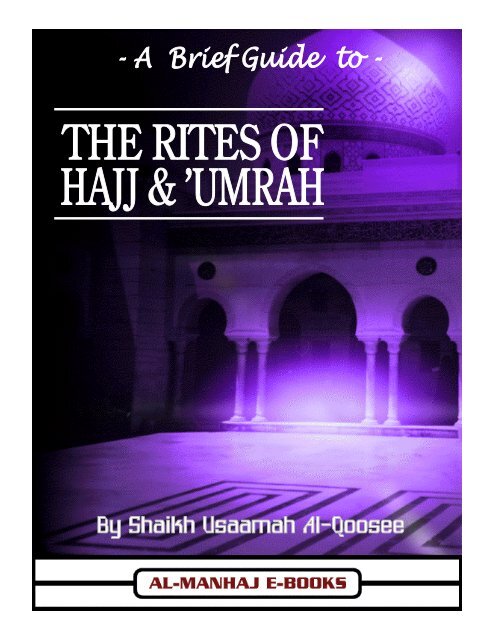


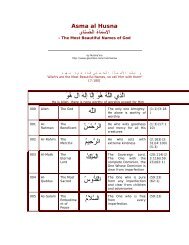
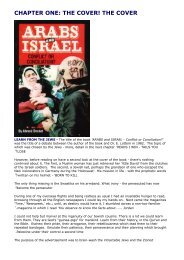
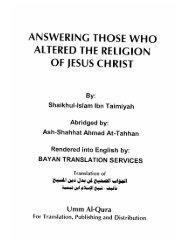


![Al-Quran - The Miracle of Miracles [ deedat]](https://img.yumpu.com/4137688/1/190x245/al-quran-the-miracle-of-miracles-deedat.jpg?quality=85)

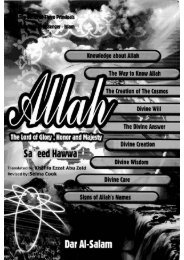



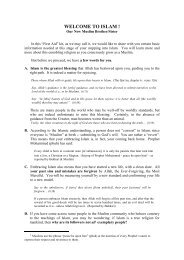
![A Collection Of Wise Sayings [ Al-Fawaid ].pdf](https://img.yumpu.com/4135801/1/190x245/a-collection-of-wise-sayings-al-fawaid-pdf.jpg?quality=85)
